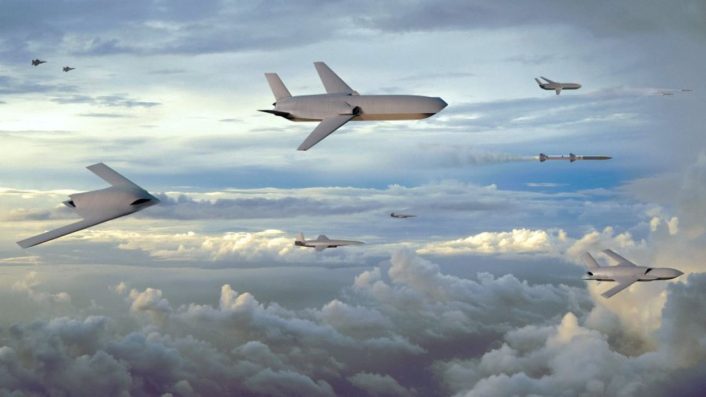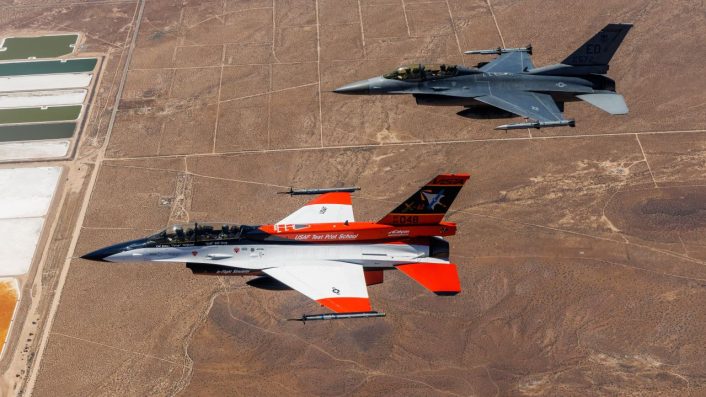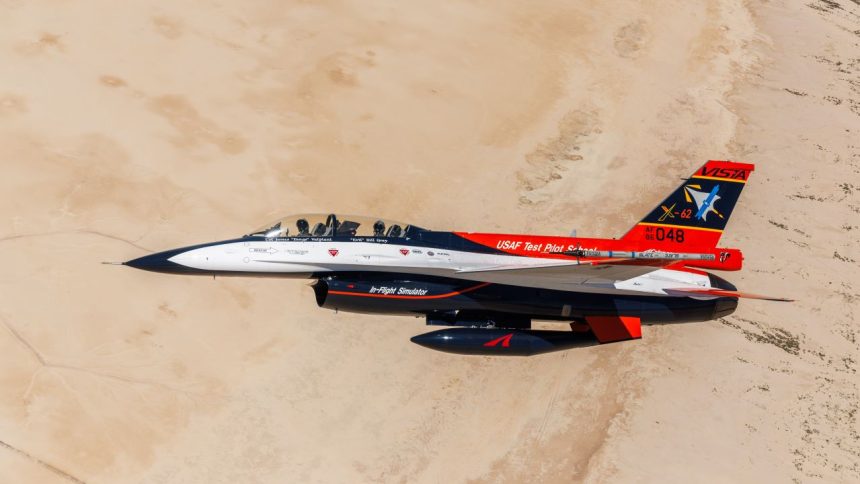Autonomy solutions for BVR combat will initially be developed and demonstrated on F-16 testbeds and then transferred to an unmanned combat aerial vehicle.
DARPA (Defense Advanced Research Projects Agency) has awarded BAE Systems’ FAST Labs arm a $4 million contract for Phase 1 of the AIR (Artificial Intelligence Reinforcements) program to develop AI (Artificial Intelligence) and ML (Machine Learning) systems for autonomous BVR (Beyond Visual Range) combat.
FAST Labs will combine AI and ML (Machine Learning) to design “models” and “simulations” with existing sensors and weapons for decision-making in complex aerial combat scenarios for “BVR (Beyond Visual Range) air combat missions.”
It also comes after U.S. Air Force Secretary Frank Kendall’s flight in the autonomous X-62A VISTA on May 2. 2024, which “incorporated ML and highly specialized software and other cutting edge technologies.”
Whether the AIR has a relationship with the X-62A VISTA is not yet clear but it is also hard not to conclude so, going by the official statements from BAE and DARPA. While BAE says that the system will be evolved and tested on “F-16 testbeds”, DARPA specifies these would be “manned F-16 test beds.” The X-62A VISTA is based on an F-16D Block 30 aircraft.
“The Air Force’s Collaborative Combat Aircraft will not only pair with the F-35 Joint Strike Fighter and the Next Generation Air Dominance platform , but also the F-15EX Eagle II, F-22 Raptor and platforms from other services or allies, according to a top Air Force official.” pic.twitter.com/IVCox86hiK
— Doha (@Doha104p3) August 15, 2024
Another program which could be involved by the AIR effort is VENOM-AFT (Viper Experimentation and Next-gen Operations Model – Autonomy Flying Testbed), which will modify the F-16 aircraft into test platforms to rapidly evaluate autonomous capabilities. Earlier this year, Eglin Air Force Base, Florida, received the first three F-16s to be modified for VENOM-AFT which, once ready, will allow to rapidly iterate and expand the body of knowledge for potential autonomy and payload solutions.
‘Autonomous air combat’
BAE Systems said that the project overcomes the “fast-paced and uncertain environment that is inherent to air combat, and presents a challenge for autonomous agents.” “The DARPA AIR program aims to advance dominant tactical autonomy for beyond visual range air combat missions. Autonomy solutions will be developed and demonstrated on F-16 testbeds.”
Kendall said in a public release after his flight in the X-62A Vista: “The potential for autonomous air-to-air combat has been imaginable for decades, but the reality has remained a distant dream up until now. In 2023, the X-62A broke one of the most significant barriers in combat aviation. This is a transformational moment, all made possible by breakthrough accomplishments of the ACE team.”
“Generating reliable, consistent air combat performance requires a vast amount of data and rapid, robust testing cycles,” said Michael Planer, scientist and principal investigator at FAST Labs. “Using machine learning, we will train the models used to make dynamic decisions – ensuring that the AI pilot is tested and trusted by human pilots.”

As The Aviationist had reported, the F-16D Block 30-based X-62A executed a range of tactical maneuvers while live agents responded in real-time to simulated threats. The flight involved completing specific test points within an aerial dogfight scenario to validate models and assess performance. Throughout the entire test flight, neither Kendall nor the safety pilot in the backseat controlled the X-62A, demonstrating its autonomous capabilities.
Earlier in Dec. 2022, “AI agents” successfully piloted the X-62A 12 times. AI agents from the AFRL (Air Force Research Laboratories) and DARPA performed one-on-one BVR (Beyond Visual Range) combat and WVR “dogfighting” respectively, executing autonomous tactical maneuvering while maintaining real-world airspace boundaries and optimizing aircraft performance.
‘AI for BVR Combat’
With aerospace powers like the U.S. and China inching towards autonomous drones, evolving them to undertake combat is the next logical step. Previously, there had been several concerns over AI being used in anti-terror, security and air-to-ground targeting roles.
But BVR combat is slightly different, where some tactical situations require linear actions, less contextual thinking and little higher-level cognitive functions. These might involve target searching, identification, tracking, prioritizing and engagement of verified adversary assets. It can unburden the pilot of several routine tasks, helping her/him focus on complex parts of the mission.
Michael Schoellhorn, CEO of Airbus Defence on Q whether Europe can support 2 fighter programmes (GCAP & FCAS) notes new Labour govt outreach to Europe might enable discussions of ‘2/3 connecting’ issues for cooperation including weapons & collaborative combat aircraft. #FIA2024 pic.twitter.com/xDiQ2n9FGQ
— Tim Robinson (@RAeSTimR) July 21, 2024
Under the AIR contract, BAE Systems will use ML “to innovate simulation models of existing sensors, electronic warfare systems, and weapons within dynamic, operationally representative environments” and “capture the underlying physics of aerial maneuvers and systems.” “The company will then create the processes needed to rapidly design, test, and deliver future iterations of AIR software products.”
The official note on AIR by Lt. Col. Ryan Hefron on DARPA’s website shares the exact same description on the use of current sensors, weapons and the realistic environments. But DARPA states the use of manned F-16s for developing the autonomous solutions, before testing them on combat drones. “Autonomy solutions will initially be developed and demonstrated on manned F-16 testbeds and then transferred to an unmanned combat aerial vehicle (UCAV).”
This means engineers would create tactical scenarios involving detecting, tracking and engaging aerial targets under various flight profiles and envelopes. The fact this would be meant for situations of BVR combat, as both DARPA and BAE note, indicates that the elementary situation itself might not be very complex and require context-based reasoning.
While undertaking swing-role missions amid highly uncertain environments like heavy AD (Air Defense) cover, EW jamming, usually close to or inside hostile territory, higher-levels of cognitive reasoning are required. Indeed, this does not mean that AI cannot be progressed to tackle these too in the future as technology develops.

AI and ML in military systems
ML is a step in AI development where the system progressively becomes error-free through routine corrections by human developers. DARPA’s AIR also marks the line where highly advanced algorithms that enable autonomy, become AI. In other words, all AIs are advanced codes and algorithms but not necessarily the other way round.
UCAVs for BVR Combat
Using UCAVs for BVR combat is not unheard of, given how Turkey is pushing the concept with its Kizilelma and Akinci UCAV. Ankara has claimed that some of these systems and its key elements are AI-enabled for the purpose. The Aviationist had noted how using drones for long-range anti-air fires is a feasible practice, especially when the air force has other supporting aircraft like Generation 4.5 jets, airborne AESA (Active Electronically Scanned Array Radars), AWACS, data links and possibly satellites.
Long-distance BVR-armed UCAVs can easily enforce an air denial in low to medium-risk aerial sectors, unburdening the frontline manned fighters. They are unviable in close-range missions where the sharp kinematic and tight-maneuvering requirements cannot be met by slow-moving drones, having weaker airframes and a control lag from the ground stations.
ÖZEL | SİHA’lara özel hava hava füzeleri geliyor!
— Türkiye, Silahlı İnsansız Hava Aracı (SİHA) aracı platformlarına havadan havaya füze entegre etmeye hazırlanıyor. Bu amaçla, yeni hava hava füzeleri geliştiriliyor.
🔗Detaylar: https://t.co/JzjHPrq4iN pic.twitter.com/QoNGTkQzOZ
— SavunmaSanayiST.com (@SavunmaSanayiST) October 15, 2023
Additionally, if the BVR-armed UCAVs or loyal wingmen are designed as attritable, mass-producible platforms, they also serve as targeting dilemmas to enemy fighters. If the air force fielding them has clear and disciplined tactics and procedures, the ‘dilemmas’ can be exploited by their manned fighters.
The most basic tactical scenario could be this: a BVR-armed UCAV refined with AI and ML flying at safe distances can detect aerial aerial targets, discriminate them through their radar profiles and release a long-range AAM. The plane would either be shot down, engage jamming to disable the AAM as it activates its terminal homing or fly away if it doesn’t have ELINT or SPJ (Self-Protection Jammers). Or, a manned fighter detects a target and cues the UCAV over a high-bandwidth, jam-resistant data link.









